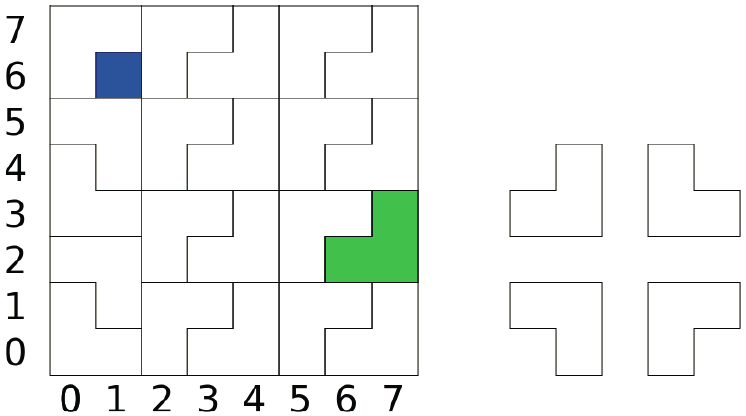IOI '14 - Taipei, Taiwan
Place tiles on the floor
We have a  by
by  floor with
floor with  unit squares. Each square can be identified by its
unit squares. Each square can be identified by its  and
and  coordinates
(both from
coordinates
(both from  to
to  ). We want to cover this floor with four
types of
). We want to cover this floor with four
types of  by
by  L-shaped tiles, as shown in the following figure. The
tiles cannot overlap, and they can only be placed on the grid boundary. In
addition, there is exactly a square that we cannot cover with tiles.
Please find a way to cover the entire floor with tiles.
L-shaped tiles, as shown in the following figure. The
tiles cannot overlap, and they can only be placed on the grid boundary. In
addition, there is exactly a square that we cannot cover with tiles.
Please find a way to cover the entire floor with tiles.
Example
In the following example we have  and
and  squares. The blue square
at
squares. The blue square
at  cannot be covered by any tile. This figure shows a possible
way to cover the floor. To identify a tile we will use the
cannot be covered by any tile. This figure shows a possible
way to cover the floor. To identify a tile we will use the  and
and  coordinates. For example, the green tile in the figure can be identified
by
coordinates. For example, the green tile in the figure can be identified
by  ,
,  , and
, and  .
.

Statement
Write a program to cover the floor with tiles.
Input Specification
The input consists of one line with  integers
integers  ,
,  , and
, and  .
.  indicates that the size of the floor is
indicates that the size of the floor is  by
by  .
.  and
and  are
the coordinates of the square that cannot be covered with tiles.
are
the coordinates of the square that cannot be covered with tiles.
Output Specification
The output should consist of a list of tile positions. Each line of the
output should contain six space-separated integers  ,
,  ,
,
 ,
,  ,
,  , and
, and  to describe the position of one
tile. For example, if we want to place the green tile as the first tile,
we can output the integers
to describe the position of one
tile. For example, if we want to place the green tile as the first tile,
we can output the integers  ,
,  ,
,  ,
,  ,
,  , and
, and  . The three squares of a
tile can appear in any order, so we can also set them as
. The three squares of a
tile can appear in any order, so we can also set them as  ,
,  ,
,  ,
,  ,
,  ,
and
,
and  . The tiles can also appear in any order.
. The tiles can also appear in any order.
Sample Input 1
Copy
1 0 0
Sample Output 1
Copy
0 1 1 0 1 1
Sample Input 2
Copy
1 1 0
Sample Output 2
Copy
0 0 0 1 1 1
Constraints
Subtask 1 [5%]

Subtask 2 [15%]

Subtask 3 [20%]


Subtask 4 [60%]


Comments